INDIAN ARMED FORCES CHIEFS ON
OUR RELENTLESS AND FOCUSED PUBLISHING EFFORTS

SP Guide Publications puts forth a well compiled articulation of issues, pursuits and accomplishments of the Indian Army, over the years

I am confident that SP Guide Publications would continue to inform, inspire and influence.

My compliments to SP Guide Publications for informative and credible reportage on contemporary aerospace issues over the past six decades.
- Prime Minister witnesses 'Bharat Shakti' – a Tri-Services Firing and Manoeuvre Exercise in Pokhran, Rajasthan
- Interim Defence Budget 2024-25 — An Analysis
- Union Defence budget 2024
- Prime Minister Modi Commemorates Indian Navy Day in a Grand Ceremony
- Prime Minister Modi Flies in the LCA Tejas
- New Chapter in India-Italy Defence Ties
- Airpower beyond Boundaries
Exercise Malabar 2016 in the strategic calculus of India
 |
By Rear Admiral Sushil Ramsay (Retd) Senior Technical Group Editor, SP's M.A.I. |
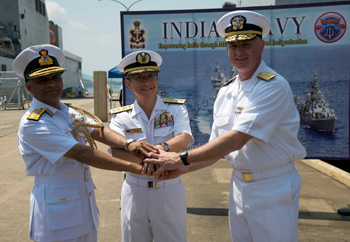
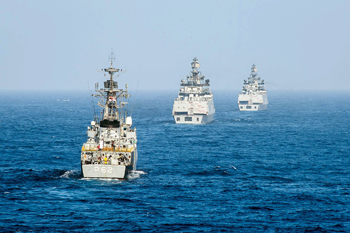
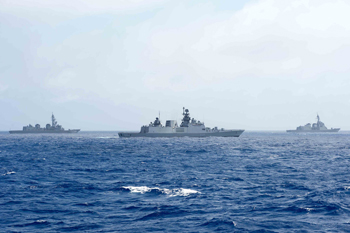
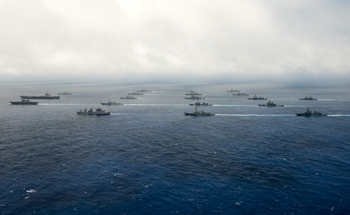
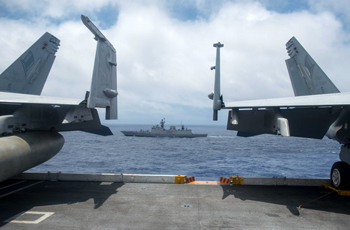
Indian Naval ships Satpura, Sahyadri, Shakti and Kirch participated in the recently concluded 20th edition of Exercise Malabar 2016 with the US Navy (USN) and Japanese Maritime Self-Defense Force (JMSDF).
The Indian Navy and the US Navy have regularly conducted the annual bilateral exercise named Malabar since 1992. Beginning from 2007, Malabar has been held alternatively off India and in the Western Pacific. The 19th edition of the exercise, Ex Malabar 2015, was conducted off Chennai and included participation of JMSDF.
The 20th edition of the exercise was conducted from June 14 to 17, 2016, with the harbour phase at Sasebo from June 10 to 13, 2016, and the tactical phase in the Pacific Ocean from June 14 to 17, 2016. The primary aim of this exercise was to increase interoperability amongst the three navies and develop common understanding of procedures for Maritime Security Operations. The scope of Malabar 2016 included professional interactions in harbour and a diverse range of activities at sea, including complex surface, sub-surface and air operations.
Indian Navy ships Sahyadri, Satpura, indigenously built guided missile stealth frigates, INS Shakti, a modern fleet tanker and support ship and INS Kirch, an indigenous guided missile corvette from Eastern Fleet participated in the exercise. Indian Navy ships had embarked one Sea King 42B, ASW helicopter and two Chetak utility helicopters.
The US Navy was represented by ships from CTF 70 of the USN 7th Fleet, which is based at Yokosuka, Japan. The CTF included aircraft carrier USS John C. Stennis (CVN 74), Ticonderoga class Cruiser USS Mobile Bay and Arleigh Burke class destroyers, USS Stockdale and USS Chung Hoon, all with embarked helicopters. In addition, one nuclear-powered submarine, carrier wing aircraft and long-range maritime patrol (LRMP) aircraft also participated in the exercise.
The JMSDF was represented by JS Hyuga, a helicopter carrier with SH 60K integral helicopters and LRMP aircraft, besides other advanced warships for specific parts of the exercise. Additionally, the Special Forces (SF) of the three navies also interacted during the exercise.
Exercise Malabar 2016 was another significant step in strengthening mutual confidence building and interoperability as well as sharing of best practices between the Indian, Japanese and US Navies. The exercise supported maritime security in the Indo-Pacific region, and to benefit the global maritime community.
In the thick of the tactical phase of the exercises, a Chinese observation ship was reported to be shadowing the US aircraft carrier, John C. Stennis in the Western Pacific, considered close to Chinese backyard, on June 15. China has always been wary of US and Japanese naval forces coming together in show of strength with the presence of surface and sub-surface units to the detriment of Chinese interests over the territorial claims in the South China Sea. China views access to the Pacific as vital, as a supply line to the rest of the world’s oceans, as also for the projection of its naval power in the region.
On the other hand, Japan is determined to regularly participate in such joint exercises as it leverages her to strengthening alliances which it hopes will help counter the growing Chinese power. Whereas Japan frequently feels threatened with frequent incursions by the Chinese warships in the disputed island territories in the East China Sea, the US is wary of China’s increasing assertive maritime role in the East Asian region. In this nexus India’s participation in the exercises with an intention to display show of force by a vibrant emerging power is congruent to the US strategy for the Indo-Pacific. The US hopes that India will eventually assume its rightful role as a pivot in the Indo-Pacific region.
In this calculus, advancing of the dates for Malabar 2016 exercises were of much deeper strategic significance for India, as it coincided with the dates for the parleys for India’s membership to the Nuclear Suppliers Group (NSG) taking place elsewhere. Just prior to this, Prime Minister Narendra Modi travelled practically half the globe to elicit support for India’s membership to the NSG. Indeed, significant gains were made through the untiring efforts of the Prime Minister, by way of unstinted support obtained from many who were not supportive of India’s cause. Coinciding with the Indian campaign was the participation of Indian maritime forces in the quadrilateral exercises in the backyard of China, very vocal opponent to India’s membership to NSG. This manoeuvre indeed sent down very strong global message to notice India as an emerging power in the region.

“Shadowing ships and submarines of other navies, although not a friendly act, is a practice adopted by most navies (including our own) at every opportunity, in order to (a) keep track of their activities; (b) gather information about their professional capabilities; (c) learn their operating procedures; and (d) record electronic and acoustic signatures of their platforms. By shadowing ships taking part in the ongoing Malabar exercise, taking place at their doorstep, the PLAN is doing what is expected of them. One hopes that this quadrilateral show of maritime force by India and its friends (not allies) will send a robust message of deterrence to an increasingly belligerent Beijing.”
— Admiral Arun Prakash, former Chief of the Naval Staff
(when asked by the SP’s M.A.I. for his comments on the incidence of shadowing of the US aircraft carrier)





